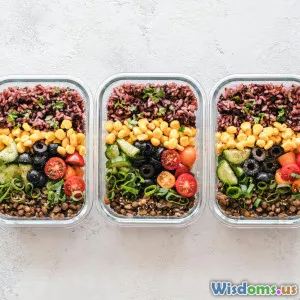
Plant Based vs Animal Protein Which Fuels Better Recovery
8 min read Explore how plant-based and animal proteins compare in fueling muscle recovery and which offers the best benefits post-exercise. (0 Reviews)
Plant-Based vs Animal Protein: Which Fuels Better Recovery?
Introduction
In the world of fitness and sports nutrition, protein reigns supreme as the cornerstone of muscle repair and recovery. With the rising popularity of plant-based lifestyles, many are questioning: does plant-based protein stack up against its animal-derived counterparts when it comes to fueling better recovery? The answer isn't straightforward, as it intertwines with biology, nutrition science, and personal lifestyle choices. This article explores the nuances of plant-based versus animal protein, providing evidence-based insights to help you make an informed decision for optimal recovery.
Understanding Recovery and Protein’s Role
Why Protein Matters for Recovery
During exercise, muscles endure microscopic damage, resulting in soreness and fatigue. Protein provides amino acids—the building blocks necessary to repair tissue, synthesize new muscle fibers, reduce inflammation, and restore strength. Adequate protein intake after workouts accelerates these processes, reducing downtime between sessions.
The Essentials: Amino Acids and Muscle Repair
Not all proteins are created equal. Essential amino acids (EAAs), especially leucine, play vital roles in stimulating muscle protein synthesis (MPS), the process where new muscle proteins are formed. A high leucine content is often associated with better muscle recovery and growth.
Animal Protein: The Gold Standard?
Complete Protein Profile
Animal proteins—found in meat, dairy, eggs, and fish—are traditionally praised for containing all nine essential amino acids in sufficient quantities, classifying them as "complete proteins." For example, whey protein, derived from milk, is rich in leucine and rapidly absorbed.
Muscle Protein Synthesis Potency
Multiple studies confirm that animal proteins like whey and casein effectively enhance MPS. A 2017 review in the Journal of the International Society of Sports Nutrition revealed whey protein's superior ability to increase MPS compared to some plant proteins, largely due to its amino acid composition and digestibility.
Accelerated Recovery Timelines
Athletes consuming animal-based proteins after resistance training often report quicker recovery and improved muscle function. High bioavailability means amino acids from animal sources enter the bloodstream faster, promoting an immediate reparative effect.
Real-World Insight:
Elena, a triathlete, shared how incorporating lean chicken and eggs into her diet post-training enabled her to withstand intense sessions and reduced soreness, offering anecdotal evidence aligned with scientific findings.
Plant-Based Protein: A Rising Contender
Incomplete but Complementary
Many plant proteins (e.g., pea, rice, hemp) lack one or more EAAs or have lower leucine content, classifying them as "incomplete proteins." However, combining different plant sources—like beans with grains—can create a complete amino acid profile.
Advancements in Plant Protein Quality
Modern processing techniques enhance digestibility and amino acid profiles. For instance, pea protein isolate contains a high amount of BCAAs (branched-chain amino acids) and is increasingly favored by athletes.
Comparable Recovery Outcomes With Adequate Intake
Emerging research challenges the notion that plant proteins are inferior for recovery. A 2020 study in Nutrients demonstrated that consuming higher doses of plant protein post-workout could produce similar MPS rates as lower doses of animal protein.
Example:
A study comparing soy protein to whey found that while whey promoted slightly higher immediate MPS, long-term muscle gains over 12 weeks were comparable in resistance-training participants.
Additional Benefits of Plant-Based Protein
Beyond muscle recovery, plant proteins often come bundled with fiber, antioxidants, and phytochemicals which reduce inflammation and improve overall health—factors that can indirectly speed recovery.
Case Study:
Sarah, a vegan marathon runner, reports that carefully planned plant-based nutrition, including lentils and quinoa, sustains her recovery needs without animal products.
Digestion and Absorption: How Do They Differ?
Digestive kinetics influence how quickly amino acids become available to muscles. Whey protein typically peaks in the bloodstream within an hour, whereas some plant proteins digest slower.
However, slower digestion rates can be beneficial for sustained amino acid delivery post-exercise. Moreover, digestive enzyme supplements and fermentation of plant proteins help increase their bioavailability.
Practical Recommendations for Optimal Recovery
Tailor Protein Intake to Your Diet
- If relying on animal proteins, 20–25g post-workout appears sufficient for stimulating recovery.
- For plant proteins, consider slightly higher intake (25–35g) and combining protein sources to ensure quality.
Timing and Distribution
Distribute protein intake evenly across meals to promote continuous muscle repair. Post-exercise consumption within a 30 to 60-minute window remains critical.
Supplement Strategies
Use high-quality isolates, such as pea or soy protein powders, combined with complementary foods for plant-based eaters. For animal-based diets, whey remains a fast-acting choice.
Consider Individual Variables
Age, training intensity, and digestive health affect protein needs and recovery efficacy.
Conclusion
The debate between plant-based vs animal protein for recovery doesn't yield a definitive winner; instead, the choice hinges on quality, quantity, and individual preferences. Animal proteins offer amino acid completeness and efficient digestion that support rapid recovery. Yet, plant-based proteins, with careful planning and sometimes increased intake, effectively fuel muscle repair and confer added health benefits.
Ultimately, embracing variety, paying attention to protein timing and amount, and personalizing diet according to one's values and physiology can optimize recovery—fueling stronger, healthier, and more sustainable athletic performance.
References:
- Phillips, S. M. et al. "Dietary Protein for Athletes: From Requirements to Optimum Adaptation." Journal of Sports Sciences, 2017.
- Joy, J. M. et al. "The Effects of Plant-Based Protein Supplementation on Muscle Recovery and Performance." Nutrients, 2020.
- Tang, J. E. et al. "Whey Protein Stimulates Greater Muscle Protein Synthesis Compared to Casein and Soy Protein in Young Men." The Journal of Nutrition, 2009.
By understanding the science and incorporating personalized strategies, you can decide which protein source best fuels your recovery and athletic goals.
Rate the Post
User Reviews
Popular Posts




















